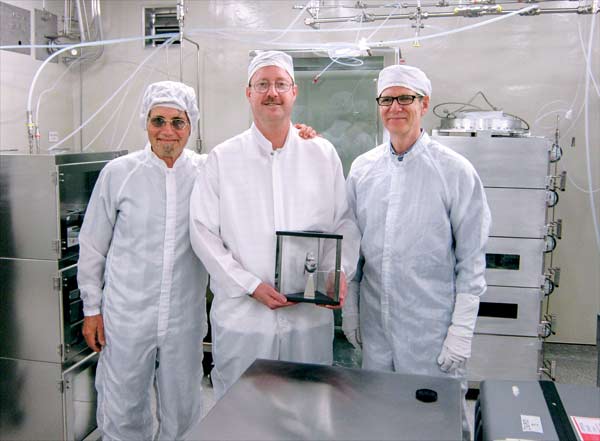Alumni Profile
David Draper
Helping NASA Shoot for the Moon—and Mars

Holding a sample of the moon retrieved during the Apollo 16 mission, David Draper (center), his brother-in-law (left) and family friend (right) are in a lab in the Astromaterials Research and Exploration Science Division at NASA's Johnson Space Center.
DAVID DRAPER (‘85, Geology) has studied our universe for nearly 30 years. Still, after all this time, the wonders of the cosmos still bring out the nerd in him.
"I grew up during the Gemini and Apollo era, so I was an absolute space geek. I've never lost that sense of awe for space and I never will," says Draper, who spent 10 years studying samples from other planets as the manager of the Astromaterials Research Office at NASA's Johnson Space Center in Houston.
Just weeks before the 50th anniversary of the historic Apollo 11 Moon landing, Draper was named NASA's deputy chief scientist and will use his expertise in planetary science to help send astronauts to the Moon and from there, on to a bigger and redder thing: Mars.
"Working for NASA is a thrill. That I'm in a position to help the agency return to the Moon and then go on to Mars is deeply fulfilling," he says.
Despite his love of all things outer space, his original plan was to be a musician—an aspiration that changed in community college during a science course, where he learned about Mount St. Helens. When the volcano erupted, Draper knew then what he wanted to do and enrolled in Humboldt State's rigorous Geology program.
"When I think about my time in Humboldt, I remember the combination of a highly stimulating intellectual environment and extreme natural beauty. HSU was food for the mind and the soul," he says.
It was also fertile ground for an aspiring geologist like Draper. He and his classmates took Geology department field trips to the nearby coast, mountains, and other areas and met professionals in the field. Perhaps one of his most formative experiences at HSU was what he learned beyond academics.
"My professors taught us not only the material but also how to learn and how to look at a problem from all angles," says Draper. "Those critical thinking skills pay off in planetary science because we're studying other worlds without knowing the full story. It's like a jigsaw puzzle where you don't know how many pieces there are and you don't have the box top so you don't even know what picture you're trying to make."
Draper, NASA, and international partners are now tackling a new puzzle. Under the project Artemis, astronauts will return to the Moon for the first time since 1972 and stay a while. During their extended visit, their goal is to research unexplored areas of the Moon and test technologies and resources that will help send them to Mars. Draper and other scientists have also proposed a separate project, the Inner Solar System Chronology mission, which would allow them to study the age of samples taken from younger parts of the Moon.
Skeptics may ask why we need to go back to the Moon and to Mars. Because, says Draper, these missions allow us to learn things about our world possible in no other way, and they fulfill a basic human need to explore.
"It's a big part of what makes us human, to ask what's over that hill? What's around that bend and what's at the end of that river? What's on the Moon? What's on Mars? Let's go find out."